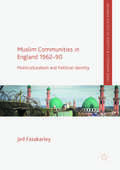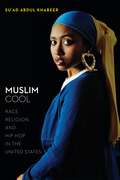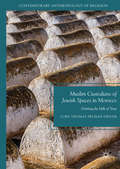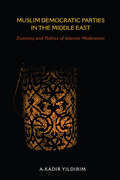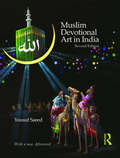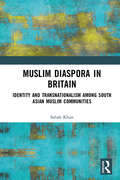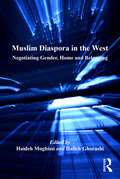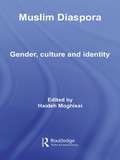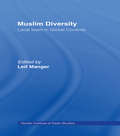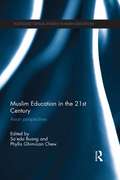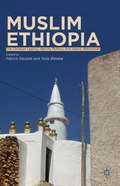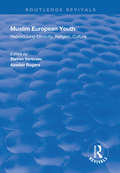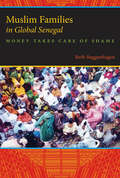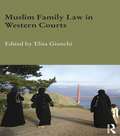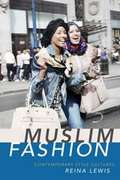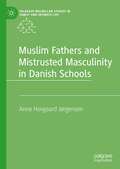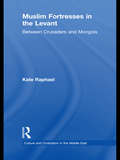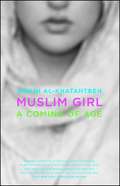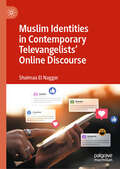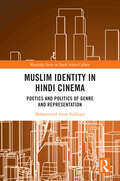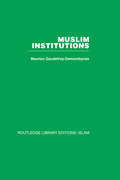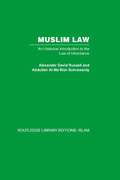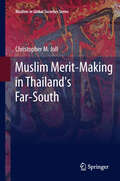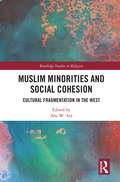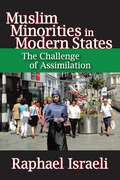- Table View
- List View
Muslim Communities in England 1962-90
by Jed FazakarleyThis book analyses Muslim integration into English society from the 1960s to the 1990s. The author argues that, contrary to common narratives built around a sudden transformation during the Rushdie affair, religious identity was of great importance to English Muslims throughout this period. The study also considers what the experiences of Muslim communities tell us about British multiculturalism. With chapters which consider English Muslim experiences in education, employment, and social services, British multiculturalism is shown to be a capacious artifice, variegated across and within localities and resistant to periodization. It is understood as positing separate ethnic communities, and serving these communities with special provisions aimed ultimately at integration. It is argued moreover to have developed its own momentum, limiting the efficacy of 21st century "backlashes" against it. Muslim Communities in England 1962-90 will be of interest to students and scholars across a range of disciplines, including sociology, history and politics.
Muslim Cool: Race, Religion, and Hip Hop in the United States
by Su'ad Abdul KhabeerInterviews with young Muslims in Chicago explore the complexity of identities formed at the crossroads of Islam and hip hopThis groundbreaking study of race, religion and popular culture in the 21st century United States focuses on a new concept, “Muslim Cool.” Muslim Cool is a way of being an American Muslim—displayed in ideas, dress, social activism in the ’hood, and in complex relationships to state power. Constructed through hip hop and the performance of Blackness, Muslim Cool is a way of engaging with the Black American experience by both Black and non-Black young Muslims that challenges racist norms in the U.S. as well as dominant ethnic and religious structures within American Muslim communities. Drawing on over two years of ethnographic research, Su'ad Abdul Khabeer illuminates the ways in which young and multiethnic US Muslims draw on Blackness to construct their identities as Muslims. This is a form of critical Muslim self-making that builds on interconnections and intersections, rather than divisions between “Black” and “Muslim.” Thus, by countering the notion that Blackness and the Muslim experience are fundamentally different, Muslim Cool poses a critical challenge to dominant ideas that Muslims are “foreign” to the United States and puts Blackness at the center of the study of American Islam. Yet Muslim Cool also demonstrates that connections to Blackness made through hip hop are critical and contested—critical because they push back against the pervasive phenomenon of anti-Blackness and contested because questions of race, class, gender, and nationality continue to complicate self-making in the United States.
Muslim Custodians of Jewish Spaces in Morocco: Drinking The Milk Of Trust (Contemporary Anthropology Of Religion Ser.)
by Cory Thomas Pechan DriverExploring the roles of Muslim guards and guides in Jewish cemeteries in Morocco, Cory Thomas Pechan Driver suggests that these custodians use performances of ritual and caring acts for Jewish graves for multiple reasons. Imazighen [Berbers] stress their close ties with Jews in order to create a moral self intentionally set apart from the mono-ethically Arab and mono-religiously Muslim Morocco. Other subjects, and particularly women, use their ties with Jewish sites to harness power and prestige in their communities. Others still may care for these grave sites to express grief for a close Jewish friend or adoptive family. In examining these motives, Driver not only documents the flow of material and spiritual capital across religious lines, but also moves beyond Muslim memory of the past on the one hand and Jewish dread of the future on the other to think about the Muslim/Jewish present in Morocco.
Muslim Democratic Parties in the Middle East: Economy and Politics of Islamist Moderation
by A. Kadir YildirimA.Kadir Yildirim and other scholars have used the term "Muslim Democrat" to describe moderate Islamist political parties, suggesting a parallel with Christian Democratic parties in Europe. These parties (MDPs) are marked by their adherence to a secular political regime, normative commitment to the rules of a democratic political system, and the democratic political representation of a religious identity. In this book, Yildirim draws on extensive field research in Turkey, Egypt, and Morocco to examine this phenomenon and assess the interaction of economic and political factors in the development of MDPs. Distinguishing between "competitive [economic] liberalization" and "crony liberalization," he argues that MDPs are more likely to emerge and succeed in the context of the former. He summarizes that the broader implication is that the economic liberalization models adopted by governments in the region in the wake of the Arab Spring have significant implications for the future direction of party systems and democratic reform.
Muslim Devotional Art in India
by Yousuf SaeedThis book highlights the history of Islamic popular devotional art and visual culture in 20th-century India, weaving the personal narrative of the author’s journey through his understanding of the faith. It begins with an introductory exploration of how the basic and universal image of Mecca and Medina may have been imported into Indian popular print culture and what variants it resulted in here. Besides providing a historical context of the pre-print culture of popular Muslim visuality, the book also explores the impact the 1947 Partition of India may have made on the calendar art in South Asia. A significant portion of the book focuses on the contemporary prints of different localised images found in India and what role these play in the users’ lives, especially in the augmentation of their popular faith and cultural practices. The volume also compares the images published in India with some of those available in Pakistan to reflect different socio-political trajectories. Finally, it discusses why such a vibrant visual culture continues to thrive among South Asian Muslims despite the questions raised by the orthodoxy on its legitimacy in Islam, and why images and popular visual cultures are inevitable for popular piety despite the orthodox Muslims’ increasing dissociation from them. This work is one of the first books on Indian Muslim poster art, with rare images and simple narratives, anecdotes about rituals, ceremonies and cultural traditions running parallel to research findings. This second edition contains a new Afterword that discusses challenges to religious plurality arising on account of changing political landscapes, economic liberalisation, technology and new media, and socio-religious developments. It will appeal to the lay reader as well as the specialist and will be especially useful to researchers and scholars in popular culture, media and cultural studies, visual art and performance studies, and sociology and social anthropology.
Muslim Diaspora in Britain: Identity and Transnationalism among South Asian Muslim Communities
by Sabah KhanThis book explores the idea of Muslim diaspora in context of Muslim communities in the United Kingdom. It critically looks at the notion of ummah and presents a comprehensive account of South Asian Muslims in London. Employing qualitative research methods and drawing on extensive fieldwork, it delves into the identification and transnational connections of Muslims in Britain. It shows the ways in which religious identity, practices and experiences may instigate diasporas focusing on South Asian Muslims in London — Indian, Pakistani and Bangladeshi Muslims — who account for 3.6 per cent of the total population. Further, the inter as well as intra group dynamics and studies how Muslims of different ethnic background settled in the same geo-political context engage with the notion of ummah. The volume will be of great interest to scholars and researchers of religion, especially Islam, politics, British studies and South Asian studies.
Muslim Diaspora in the West: Negotiating Gender, Home and Belonging (Research in Migration and Ethnic Relations Series)
by Haideh Moghissi Halleh GhorashiIn view of the growing influence of religion in public life on the national and international scenes, Muslim Diaspora in the West constitutes a timely contribution to scholarly debates and a response to concerns raised in the West about Islam and Muslims within diaspora. It begins with the premise that diasporic communities of Islamic cultures, while originating in countries dominated by Islamic laws and religious practices, far from being uniform, are in fact shaped in their existence and experiences by a complex web of class, ethnic, gender, religious and regional factors, as well as the cultural and social influences of their adopted homes. Within this context, this volume brings together work from experts within Europe and North America to explore the processes that shape the experiences and challenges faced by migrants and refugees who originate in countries of Islamic cultures. Presenting the latest research from a variety of locations on both sides of The Atlantic, Muslim Diaspora in the West addresses the realities of diasporic life for self-identified Muslims, addressing questions of integration, rights and equality before the law, and challenging stereotypical views of Muslims. As such, it will appeal to scholars with interests in race and ethnicity, cultural, media and gender studies, and migration.
Muslim Diaspora: Gender, Culture And Identity (Routledge Islamic Studies Ser.)
by Haideh MoghissiMuslim Diaspora
Muslim Diversity: Local Islam in Global Contexts (Nias Studies In Asian Topics Ser. #No.26)
by Leif MangerThe term 'local Islam' has been coined to describe local responses to the effects of globalisation in the Islamic world. All contributions to this volume present cases of 'local Islam' as well as discussing the term itself. But what all of this group of anthropologists and historians convey is a feeling of dissatisfaction with the very term. Their uneasiness relates to the conceptual problems arising from seeing Islam as either local or global. Rather, the authors argue in favour of a focus not on Islam but on the lives of Muslims, putting their lives into the context of complex historical developments. Ranging across much of the vast extent of the Islamic world - from West Africa and the Near East to China and Southeast Asia - the contributions deal with the effects of migration on local Islamic traditions in Bangladesh; conflicts between Muslim sects in Pakistan; the development of jihad in West Africa; the problem of maintaining a Muslim identity in China; how Javanese Muslims combine their Islamic faith with belief in a local Javanese spirit world; the comparison between urban- and rural-based Islam in Syria; and (in two studies from western Sudan) issues of belief and broader aspects of identity management in a multi-ethnic situation.
Muslim Education in the 21st Century: Asian perspectives (Routledge Critical Studies in Asian Education)
by Phyllis Ghim-Lian Chew Sa'Eda BuangMuslim Education in the 21st Century reinvestigates the current state of affairs in Muslim education in Asia whilst at the same time paying special attention to Muslim schools’ perception of educational changes and the reasons for such changes. It highlights and explores the important question of whether the Muslim school has been reinventing itself in the field of pedagogy and curriculum to meet the challenges of the 21st century education. It interrogates the schools whose curriculum content carry mostly the subject of religion and Islam as its school culture. Typologically, these include state-owned or privately-run madrasah or dayah in Aceh, Indonesia; pondok, traditional Muslim schools largely prevalent in the East Malaysian states and Indonesia; pesantren, Muslim boarding schools commonly found in Indonesia; imam-khatip schools in Turkey, and other variations in Asia. Contributed by a host of international experts, Muslim Education in the 21st Century focuses on how Muslim educators strive to deal with the educational contingencies of their times and on Muslim schools’ perception of educational changes and reasons for such changes. It will be of great interest to anyone interested in Asian and Muslim education.
Muslim Ethiopia
by Patrick Desplat Terje �steb�With a particular focus on the role of situated actors, this book sheds light on the emergence and expansion of Salafism in Bale, Ethiopia from the late 1960s, through the Marxist period (1974-1991) before discussing the rapid expansion and fragmentation of the movement in the 1990s until 2006.
Muslim European Youth: Reproducing Ethnicity, Religion, Culture (Routledge Revivals)
by Steven Vertovec Alisdair RogersFirst Published in 1998, this volume consists of contributors providing position of Muslim youth in a European context. Providing case studies from 5 European nations: Denmark, France, Germany, the Netherlands and the United Kingdom. The chapters in this book draw from various of anthropological and sociological theory to discuss this topic. Many contributors relating back to ethnological research on young Muslims in relation to local government, political and religious associations, schools as well as community and family.
Muslim Families in Global Senegal: Money Takes Care of Shame
by Beth Buggenhagen“A first-rate ethnography of Muslim women in Dakar . . . [an] extremely fine-grained analysis of women’s exchange networks.” —Robert Launay, Northwestern UniversitySenegalese Murid migrants have circulated cargo and currency through official and unofficial networks in Africa and the world. Muslim Families in Global Senegal focuses on trade and the transmission of enduring social value though cloth, videos of life-cycle rituals, and religious offerings. Highlighting women’s participation in these networks and the financial strategies they rely on, Beth Buggenhagen reveals the deep connections between economic profits and ritual and social authority. Buggenhagen discovers that these strategies are not responses to a dispersed community in crisis, but rather produce new roles, wealth, and worth for Senegalese women in all parts of the globe.“A lively, insightful, and important study of exchange practices between Senegal and a circuit of global trade. The innovative focus is on the meanings, not the social and economic functions, of exchange.” —Karen Tranberg Hansen, Northwestern University“While the author’s focus is on the transformation in the role of women both within the family network and in the marketplace, the book allows readers to better understand the impact of globalism on the citizens of Senegal . . . Recommended.” —Choice
Muslim Family Law in Western Courts (Durham Modern Middle East and Islamic World Series)
by Elisa GiunchiThis book focuses on Islamic family law as interpreted and applied by judges in Europe, Australia and North America. It uses court transcriptions and observations to discuss how the most contentious marriage-related issues - consent and age of spouses, dower, polygamy, and divorce - are adjudicated. The solutions proposed by different legal systems are reviewed , and some broader questions are addressed: how Islamic principles are harmonized with norms based on gender equality, how parties bargain strategically in and out of court, and how Muslim diasporas align their Islamic worldview with a Western normative narrative.
Muslim Fashion: Contemporary Style Cultures
by Reina LewisIn the shops of London's Oxford Street, girls wear patterned scarves over their hair as they cluster around makeup counters. Alongside them, hip twenty-somethings style their head-wraps in high black topknots to match their black boot-cut trousers. Participating in the world of popular mainstream fashion--often thought to be the domain of the West--these young Muslim women are part of an emergent cross-faith transnational youth subculture of modest fashion. In treating hijab and other forms of modest clothing as fashion, Reina Lewis counters the overuse of images of veiled women as "evidence" in the prevalent suggestion that Muslims and Islam are incompatible with Western modernity. Muslim Fashion contextualizes modest wardrobe styling within Islamic and global consumer cultures, interviewing key players including designers, bloggers, shoppers, store clerks, and shop owners. Focusing on Britain, North America, and Turkey, Lewis provides insights into the ways young Muslim women use multiple fashion systems to negotiate religion, identity, and ethnicity.
Muslim Fathers and Mistrusted Masculinity in Danish Schools (Palgrave Macmillan Studies in Family and Intimate Life)
by Anne Hovgaard JørgensenThis book seeks to provide a deeper understanding of Muslim migrant fathers’ experiences of home-school cooperation in Danish schools by identifying and contradicting a phenomenon of “mistrusted masculinity.” This term refers to a negative stereotype of Muslim migrant men that figures in political and media rhetoric where they are portrayed as controlling and patriarchal. Throughout the ethnography, migrant fathers confront this stereotype and express how they must navigate around this negative image in their struggle to be acknowledged as good fathers by their children’s schools. Jørgensen uses Geertzian “thick description” of micro-interaction between fathers and Danish teachers to explore the complex interplay of often-untested assumptions, misunderstandings, and untoward effects.
Muslim Fortresses in the Levant: Between Crusaders and Mongols (Culture and Civilization in the Middle East)
by Kate RaphaelDuring much of the twelfth century the Crusaders dominated the military scene in the Levant. The unification of Egypt and Syria by Saladin gradually changed the balance of power, which slowly begun to tilt in favour of the Muslims. This book examines the development and role of Muslim fortresses in the Levant at the time of the Crusaders and the Mongol invasion, situating the study within a broad historical, political and military context. Exploring the unification of Egypt with a large part of Syria and its effect on the balance of power in the region, Raphael gives a historical overview of the resulting military strategies and construction of fortresses. A detailed architectural analysis is based on a survey of four Ayyubid and eight Mamluk fortresses situated in what are today the modern states of Jordan, Israel, Southern Turkey and Egypt (the Sinai Peninsula). The author then explores the connection between strongholds or military architecture, and the development of siege warfare and technology, and examines the influence of architecture and methods of rule on the concept of defence and the development of fortifications. Drawing upon excavation reports, field surveys and contemporary Arabic sources, the book provides the Arabic architectural terminology and touches on the difficulties of reading the sources. Detailed maps of the fortresses in the region, the Mongol invasion routs, plans of sites and photographs assist the reader throughout the book, providing an important addition to existing literature in the areas of Medieval Archaeology, Medieval military history and Middle Eastern studies.
Muslim Girl: A Coming of Age
by Amani Al-KhatahtbehRequired reading from the founder of MuslimGirl.com--a harrowing and candid memoir about coming of age as a Muslim American in the wake of 9/11, during the never-ending war on terror, and through the Trump era of casual racism.At nine years old, Amani Al-Khatahtbeh watched from her home in New Jersey as two planes crashed into the World Trade Center on September 11, 2001. That same year, she heard her first racial slur. At age eleven, when the United States had begun to invade Iraq and the television was flooded with anti-Muslim commentary, Amani felt overwhelmed with feelings of intense alienation from American society. At thirteen, her family took a trip to her father's native homeland of Jordan, and Amani experienced firsthand a culture built on pure religion, not Islamic stereotypes. Inspired by her trip and after years of feeling like her voice as a Muslim woman was marginalized and neglected during a time when all the media could talk about was, ironically, Muslim women, Amani created a website called MuslimGirl. As the editor-in-chief, she put together a team of Muslim women and started a life dedicated to activism. This is the extraordinary account of Amani's journey through adolescence as a Muslim girl, from the Islamophobia she's faced on a daily basis, to the website she launched that became a cultural phenomenon, to the nation's political climate in the 2016 election cycle with Donald Trump as the Republican nominee. While dispelling the myth that a headscarf makes you a walking target for terrorism, she shares both her own personal accounts and anecdotes from the "sisterhood" of writers that serve as her editorial team at MuslimGirl. Amani's honest, urgent message is fresh, timely, and a deeply necessary counterpoint to the current rhetoric about the Middle East.
Muslim Identities in Contemporary Televangelists' Online Discourse
by Shaimaa El NaggarThis book examines the discourse of Muslim televangelism in the West, particularly looking at the emergence of 'home-grown' televangelists who grew up in the West and deliver their sermons in English, addressing audiences in contexts such as the UK and the USA. In their sermons, televangelists address topics that are relevant to the everyday life of Muslims and Muslim youth such as friendship, marriage and the misrepresentation of Islam/Muslims in mass media. This book explores contemporary Muslim televangelism and its manifestations in other forms of digital religion, including YouTube, websites and social media which mediate religious content. Using a Critical Discourse Studies approach, the author explores the power structures underpinning the popularity of Muslim televangelism, investigates the linguistic strategies used by Muslim televangelists to construct their identities online, and analyses how Islam and Muslims are represented in their sermons. This book will be of interest to religious studies, media studies, and discourse studies scholars, and to anyone interested in the topic of Islam/Muslims in the West in the contemporary age.
Muslim Identity in Hindi Cinema: Poetics and Politics of Genre and Representation (Routledge Series on South Asian Culture)
by Mohammad Asim SiddiquiThis book examines the representation of Muslim identity in Hindi films by focusing on different aspects of Muslim identity - historical, cultural, and linguistic - and their realisation in cinematic form.The book assesses the changing perceptions of Muslim identity, beginning from the historical films of the 1940s to the more recent films which often address the current stereotypical notions of Muslim identity in the post-9/11 world and in particular, analyses films which treat the problematic of "global Muslim identity". It argues that genre, language, and various sign systems create understandings and mediate notions of identity. Offering a close reading of films belonging to different genres - Muslim social, action thriller, gangster, biopic, and many others - the book interrogates concepts of social diversity, tokenism, marginality, and their reflection and consolidation in Hindi films. It critically looks at the representation of Muslim women characters and the politics of interfaith romances in many films. The book also reads many films which probe Partition violence, communal riots and the international discourse on terror. It also touches on the evolution of the language of Hindi films and its role in creating a lingua franca uniting diverse and variegated groups of people in India. Drawing insights from new critical close reading, deconstruction, semiotic and discourse analysis, the book also offers a close reading of a few films in each chapter, which offer important insights into Hindi cinema.This book offers a unique and comprehensive analysis of the political and representational aspects of Hindi cinema, portrayal of Muslims in popular arts, and the debates and politics over the use of Hindustani in India and its identification with religious and communitarian identity. It will be of interest to researchers studying world cinema, Hindi cinema, sociology and Asian studies.
Muslim Institutions
by Maurice Gaudefroy-DemombynesOriginally published in 1967, this Companion is designed to help readers of the Qur’an by giving them necessary background information. An account is given of ideas peculiar to the Qur’an, and the main variant interpretations are noted. A full index of Qur’anic proper names and an index of words commented on has been provided. Based on A J Arberry’s translation, this Companion can be used with other translations, or indeed with the original text, since the verses are numbered.
Muslim Law: An Historical Introduction to the Law of Inheritance
by Alexander David RussellThis volume, orginally published in 1925, outlines the historical development of the Muslim law of inheritance in pre-Islamic Law. It discusses the ranking of heirs and guardians, reforms introduced by Muhammad, subsequent development of the law, and rise of the orthodox schools.
Muslim Merit-making in Thailand's Far-South
by Christopher M. JollThis volume provides an ethnographic description of Muslim merit-making rhetoric, rituals and rationales in Thailand's Malay far-south. This study is situated in Cabetigo, one of Pattani's oldest and most important Malay communities that has been subjected to a range of Thai and Islamic influences over the last hundred years. The volume describes religious rhetoric related to merit-making being conducted in both Thai and Malay, that the spiritual currency of merit is generated through the performance of locally occurring Malay adat, and globally normative amal 'ibadat. Concerning the rationale for merit-making, merit-makers are motivated by both a desire to ensure their own comfort in the grave and personal vindication at judgment, as well as to transfer merit for those already in the grave, who are known to the merit-maker. While the rhetoric elements of Muslim merit-making reveal Thai influence, its ritual elements confirm the local impact of reformist activism.
Muslim Minorities and Social Cohesion: Cultural Fragmentation in the West (Routledge Studies in Religion)
by Abe W. AtaThis book examines various attempts in the ‘West’ to manage cultural, linguistic, and religious diversity – focusing on Muslim minorities in predominantly non-Muslim societies. An international panel of contributors chart evolving national identities and social values, assessing the way that both contemporary ‘Western’ societies and contemporary Muslim minorities view themselves and respond to the challenges of diversity. Drawing on themes and priority subjects from Islamic Culture within Euro-Asian, Australian, and American international research, they address multiple critical issues and discuss their implications for existing and future policy and practice in this area. These include subjects such as gender, the media, citizenship, and multiculturalism. The insight provided by this wide-ranging book will be of great use to scholars of Religious Studies, Interreligious Dialogue and Islamic Studies, as well as Politics, Culture, and Migration.
Muslim Minorities in Modern States: The Challenge of Assimilation
by Raphael IsraeliPolitical leaders of the 1930s may be accused of blindness to danger in their failed attempts to appease totalitarian aggression, but no one doubts they believed they were doing so to preserve their way of life. In contrast, Raphael Israeli suggests that twenty-first century appeasement of Islamists, wherever it occurs, is different. Appeasement in the advanced modern states of this century - in Europe, Australia, Canada, and even in parts of Asia - is characterized by what amounts to a self-inflicted humiliation, in misguided efforts to slow the advance of a rising Islamist tide. Such appeasement surrenders core aspects of sovereignty, turning non-Muslim populations into second- and third-class citizens in their own countries.Disturbing warning signs first emerged in Europe, but were either not noticed or denied. They extended to the periphery of the Muslim world, but their development in Western countries were unnoticed or denied, until they hit also the peripheral areas of the Muslim world. Canada and Australia, and to some extent the countries of Asia, fell into a syndrome of denial, which persisted until they were forced to listen, often at a price in human lives and carnage. In Europe, the core of the Muslim presence developed in countries like Britain, France and Germany, which lacked law-enforcement against terrorists because the executive and judiciary emphasized human rights and apparent safety over defensive measures to protect their citizens and way of life.Both the United States and Great Britain needed a traumatic jolt before they moved to act. In the United States, it would be the watershed event of September 11, 2001; in London, the July 7, 2005 bombings. And there were events in other countries: in Spain, the March 2004 Madrid train bombings; in France, the violent riots of 2005; in Amsterdam, the van Gogh murder; in Asia, the Bali horror; and finally in Scandinavia, the Cartoon Affair. These jolts shattered the tranquility of populations who had believed in peaceful coexistence with Muslim immigrants and in the feasibility of their integration into national societies. This study fills a large void in the examination of the consequences of new migrations of Muslim populations into advanced and modern societies throughout the world.
